
Home > general information > Tips and Guides > Technical guides > Generalists >
What documents when buying a used motorcycle?
When selling a used motorcycle, the seller must give you three documents:
- the grey card
- the certificate of situation (formerly called non-pledge certificate)
- the transfer certificate (CERFA documents) in 2 copies (one for each of the parties)
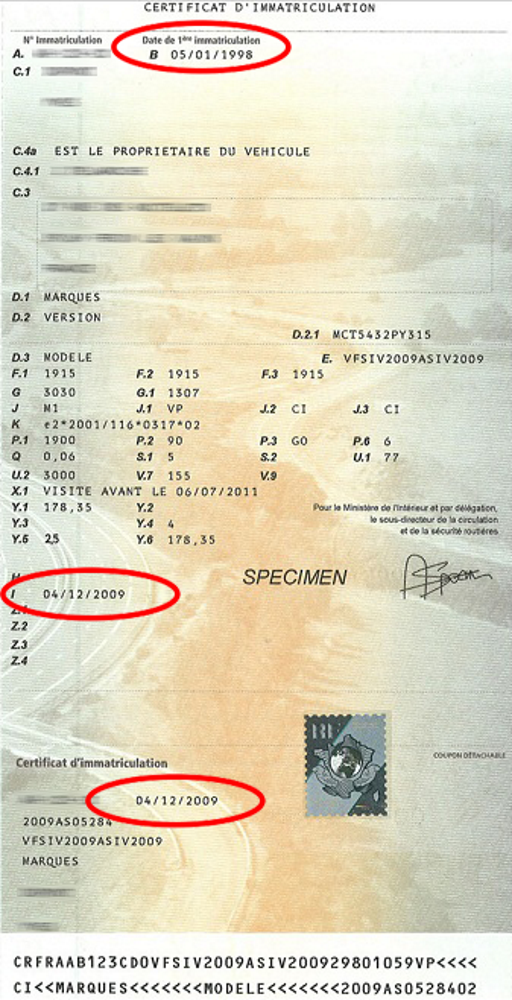
The gray card of a motorcycle
It is important that the person holding the vehicle registration document is the one offering the motorcycle for sale.
The dates :
On the gray card, it is possible to read a maximum of 3 dates which allow you to have a small idea of the life of the vehicle you wish to buy:
- At the top and on the right: "date of 1st entry into circulation" which is used for the quotation of the vehicle.
- At the top and in the middle: "date" which is the date on which the gray card in the name of the current owner was established.
- At the bottom and in the middle: "date and previous certificate number" which will mention the date on which the registration previous to that of the current owner was ©established.
If the same date is entered in the "date of first circulation" and "date" sections, while in the "date and previous certificate number" section appears the mention  “Nine”, you are in the presence of a first-hand vehicle.
If the "Date of 1st first circulation" and "Date and previous certificate number" fields show the same date while a different date appears in the field “Date†refers to a vehicle that had two different owners.
In this case, it is possible to encounter vehicles whose owner has changed address or who have been issued a duplicate registration document. In these two cases, the mentions "duplicate issued on …" and "change of domicile" appear on the top of the gray card.
If the dates appearing in these zones are all different, you are probably in the presence of a vehicle having had at least three different owners.
In the same vein, be very careful and ask for precise explanations when the "date" zone and the "date and previous certificate number" zone mention dates close to each other (less than 6 months). In fact, when there is traffic in stolen vehicles or the recirculation of wrecks, it is very common to witness successive and rapid changes of ownership. to cover the tracks.
Last check to make:
Check that the number written on the gray card in the "number in the type series" area corresponds to the one appearing on the frame of the motorcycle.
Since 2009, the Carte Grise has changed form, as have the procedures accompanying the purchase/sale of a used motorcycle. The registration of the motorcycle now follows it throughout its life. It is accompanied by a registration plate of a format that evolves over the legislation. The latest (as of July 1, 2018), imposes a plate of 210 x130 mm.
Composition of the gray card:
The Carte Grise (or Registration Certificate) is made up of three sections. A front, a back and a detachable part. Here's how to decipher and understand the information on the 3-pane document.
Stream 1
The different fields of the first pane make it possible to identify the vehicle and its owner.
Stream 2
Technical information relating to the vehicle (from name to weight) passing par the sound level when the vehicle is stationary.
Stream 3
This detachable flap will be given to you at the time of the sale. It synthesizes information about the vehicle. The seller will have to send you a code which you will be asked for when applying online for the registration certificate.
This section will act as a provisional gray card, pending the new registration certificate. On the back, you will indicate your name and address.
Special features for vintage motorcycles
The motorcycle does not have a registration document: either the owner has lost it or he never had it.
In the first case, simply declare the theft to the prefecture by completing the document CERFA 13753*02. This declaration makes it possible to request a duplicate gray card.
In the second case, the motorcycle will not be able to travel on public roads unless the vehicle is over thirty years old, a gray card for a collector's vehicle may be requested.
The absence of the document must be considered suspicious, and you ask about the origin of the motorcycle.
The gray card is not in the name of the seller.
Example of a cascading sale without the successive owners having done what is necessary for the gray card. It is either a motorcycle to be restored which will have discouraged successive owners or an object of speculation. Here too, it is better to move on.
The gray card exists but the motorcycle does not appear in the "AN" database.TS ».
In this case, only the owner (seller) will be able to request REA (Resumption of previous state). This operation means a new registration SIV (new registration document and new plate).
Normal or collection gray card?
Born in 1984, the collector's registration card has made it possible to put many vehicles back into circulation that had not been re-registered in 1955 during the reform of the system numbering or whose papers had been lost. Until 2009, collector vehicles were subject to traffic restrictions.
This collector's gray card only concerns vehicles over thirty years old.
To obtain this card, you will need the Registration Certificate. The form can be downloaded from the website of the FFVE (French Federation of Vintage Vehicles) and to be returned completed. Manufacturers and importers generally issue this document.
The certificate of administrative situation for a motorcycle
It is composed of 2 certificates: certificate of non-opposition and certificate of non-pledge.
Ce certificate allows you to know if a particularity prevents the sale. It proves that the vehicle is not the subject of any offense (unpaid fine, reported theft, etc.). The document clearly indicates that the vehicle does not show any particularity at the date of publication of the document.
The following information can be found on the certificate:
- Registration of pledge (debt related to the vehicle)
- The bailiff's opposition (claim sometimes linked to a debt)
- The opposition of the Treasury (unpaid fines and tickets)
- The VGA (seriously damaged vehicle) and VEI (economically irreparable vehicle) procedure
- The presence of the information "the vehicle is reported stolen"
- The presence of a mention of the type "mutated" or "destroyed"
This certificate must be dated less than 15 days before the sale. If an opposition procedure is initiated, the holder of the gray card cannot sell his vehicle. This is particularly the case if it has been in an accident and is considered dangerous, if it is declared stolen or if the owner does not ™has not paid the fines concerning him.
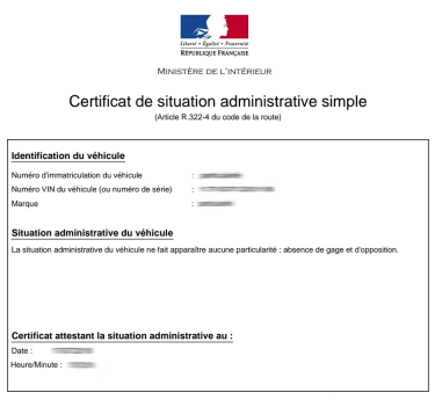
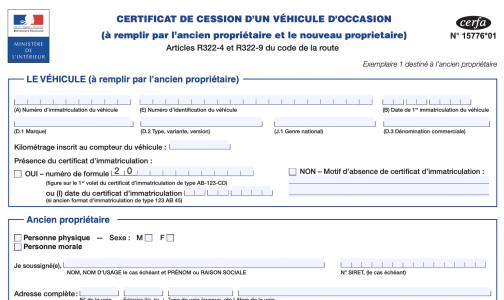
Certificate of assignment (CERFA 15776*02 form)
It's the document which justifies the transfer of ownership and allows the registration of the sale, releasing the seller from any liability in the event of offenses committed par the acquirer.
The declaration of assignment must be established within 15 days of the transaction. It allows you to retrieve a transfer code, valid for 15 days par the seller who will transmit it to the buyer. Indeed, without this code, the new owner cannot register the vehicle in his name.
The seller keeps copy number 1 and gives copy number 2 to the buyer.
Explanations of the letters of the 3 sections of a gray card:
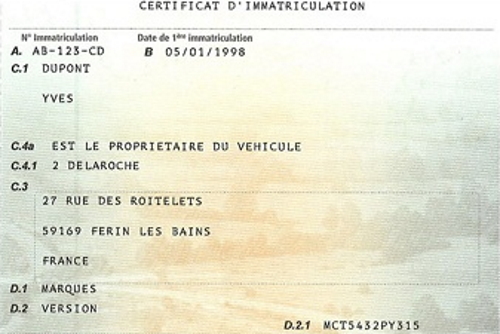
Component 1:
A Registration number. The number on the license plate.
B Date of first circulation. Date on which the motorcycle was registered for the first time: when it left the dealership.
C.1 Identity of the holder of the registration certificate. The name and surname of the vehicle owner. It can be a legal person, but also a company. The holder receives the tickets and is legally responsible for the vehicle.
C.3 Holder's address.
C.4.a Mention indicating that the holder of the gray card is the owner of the vehicle.
C.4.1 Mention indicating that the holder of the gray card is the owner of the vehicle.
D.1 Vehicle brand. Who is the motorcycle manufacturer?
D.2 Specific model or version of the vehicle. Particular and unique denomination of the model. May be empty in the case of a motorcycle.
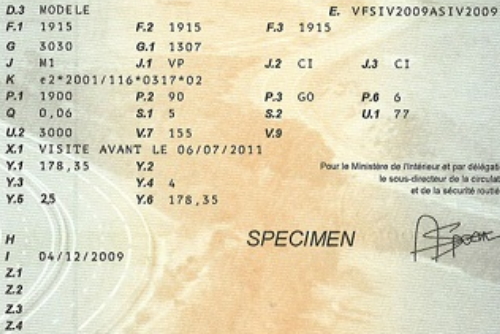
Component 2:
D.2.1 National identification code.
D.3 Trade name. May be empty in the case of a motorcycle.
E VIN code. The most important number when you want to order parts. This 17-character code provides information on the exact year and model of your motorcycle.
F.1 Technically permissible maximum laden mass (in kg)
F.2 Maximum permissible laden mass par the vehicle in service (in kg)
F.3 Maximum permissible laden mass of the assembly in service (in kg)
G Mass of the vehicle in service with bodywork and coupling device (in kg)
G.1 National curb weight (in kg)
J Vehicle category according to European standards (CE)
J.1 Vehicle type (MTT1 or MTT2). Indicates if the motorcycle is restricted (MTT1) or if it is not (MTT2), in accordance with the new legislation in force. If you startridez your second-hand motorcycle, a procedure in the prefecture is necessary in addition to that carried out in the dealership.
J.2 Body type (European standards)
J.3 Body type (national standards). Solo for motorcycles.
K Receipt number par type (when the motorcycle is imported from another country).
P.1 Displacement (in cc)
P.2 Maximum net power (in kW)
P.3 Type of fuel or energy (petrol, electricity, biofuel…)
P.6 National administrative power (number of tax horses). This number takes into consideration the tax horsepower value of the region of registration and the carbon dioxide emission rate. It also determines the price of the gray card.
Q Power/mass ratio in kW/kg (for motorcycles)
S.1 Number of seats (1 or 2 for the motorcycle)
S.2 Number of standing places (0 for the motorcycle)
U.1 Sound level when stationary (in dB)
U.2 Engine rotational speed (measurement engine speed in rpm)
V.7 Rate of CO2 released into the air (over one km in normal driving). Concerns motorcycles put into circulation after June 2004.
V.9 CE approval environmental class
X.1 Date of the next technical inspection on the date of issue of the registration certificate
Y.1 Regional proportional tax amount
Y.2 Amount of the additional parafiscal charge
Y.3 Amount of the additional CO² tax or ecotax
Y.4 Amount of the tax for management of the registration certificate
Y.5 Amount of the fee for delivery of the registration certificate
Y.6 Total amount of tax payable
H Period of validity of the registration certificate (for exceptional authorizations par example)
I Date of last registration
Z.1 to Z.4 Specific mention






